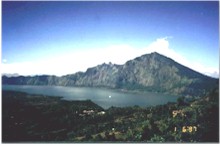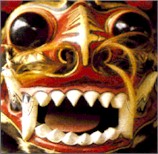

Travellers' notes welcomed here
 Sunset at Kuta Beach
Sunset at Kuta Beach
One of the 17,508 islands of the Indonesian archipelago, Bali plays up to the Western notion of an exotic island in the East of sun-drenched sandy beaches, fringed by waving coconut trees and women in itsy-bitsy skimpy bikinis. Well, all that is true. But there are also the less innocuous and definitely more charming aspects beneath the surface: the Balinese and their culture.
This isle at the eastern tip of Java has a mountainous terrain consisting of volcanoes some of whom are live. The tallest mountain, Gunung Agung, according to legend is the "navel" of the world. The mountains contribute to another unique scene of Bali: terraced rice pastures sculpted on the fertile soils on the mountains.
 Lake
Batur, Bali's largest lake atop a volcano
Lake
Batur, Bali's largest lake atop a volcano
Myth has it that the 3 million inhabitants on Bali today are descended from a couple created by the Great God, Sang Hyang Widi.
 Unlike the rest of Islamic
Indonesia, Bali's population is mainly Hindu. This is evidence by
the numerous temples around every corner and the conspicuous lack
of women wearing the Islamic head-dress. Bali's Hinduism
originates from India but it has evolved into a highly dramatized
form, which can be witnessed by visitors in the form of dances at
traditional festivals and at secular performances.
Unlike the rest of Islamic
Indonesia, Bali's population is mainly Hindu. This is evidence by
the numerous temples around every corner and the conspicuous lack
of women wearing the Islamic head-dress. Bali's Hinduism
originates from India but it has evolved into a highly dramatized
form, which can be witnessed by visitors in the form of dances at
traditional festivals and at secular performances.
Amidst such a backdrop, it is little wonder that the vibrant Balinese culture is among the most colourful in Asia.

 A traditional Balinese painting, Wayne Reid
A traditional Balinese painting, Wayne Reid
Art is an integral part of the Balinese culture. Each village is supposedly famed for a certain artistic creation be it wood or stone carvings, jewelry craftings, batik paintings or barong dances. Peasants by day; artists by night: it is no exaggeration to say that there are as many artists in Bali as there are people.
Dynamic and agile, Balinese barong dance is exciting theatre, filled with sharp corner-turnings, intricate coordination of eyeball, finger, neck and shoulder movements. Entertaining, elegant and captivating, the dances are performed according to strict tradition; the players are forbidden to improvise the movements learned and perfected since early childhood. There are daily performances at a few villages. To get there, inquire first at your hotel lobby or any of the local tour guides.
The traditional style of paintings depict aspects of religious life or mystical characters, painted in sombre hues of yellow, red and black, or sometimes in plain charcoal. Contemporary adaptation and external influences have resulted in new themes: often in vibrant colors, featuring people, animals and abstract imagery, that are different yet uniquely Balinese. Whichever way, these artifacts make interesting centrepieces for the home. See Treasure Island: Shopper's paradise and Art: Bargaining
According to Hindu belief, life on Earth is but a stage in the continuity of existence. The cycle begins at birth, a cherished and important event for the family because the child is believed to be the reincarnation of an ancestor destined to live again in an earthly form.
Death is an elaborate event. The climatic cremation frees the soul from Earth to begin its heavenly journey before reincarnation. Cremation normally takes place about 42 days after death. Due to its festive nature, the ceremony does not come cheap. To raise funds, the cremation may take place much later (although too long a wait may condemn the soul to wander the Earth - bringing ill omens), alternatively, the solution is in collective cremations.
The body of the deceased is unearthed, washed and placed onto a tower, or “wada” to be carried in a procession to the funeral pyre. The bearers of the wada, who may number a hundred or more, march the body, whirling and tilting it to confuse the soul, lest it try to return to its earthly home.
At the pyre, the body is put into a sarcophagus, which has been shaped appropriately for the person’s caste along with offerings and money. It is blessed and then incinerated. Once consumed by the fire, the ashes are collected into coconut shells to be thrown into the sea or a stream.
Forty days after the funeral, another ceremony, the mukur is held to mark the entry of the person into heaven.
If you have a stomach for the macabre, try catching a cremation ceremony. Check out the brochures at your hotel lobby as they do not take place daily unlike the barong dances.
Forget DKNY or Versace when shopping in Bali. Here, handmade crafts rule the shopping scene. Anything that could be carved or fashioned out of wood, silver or cloth will tempt your tourist dollar. The best part is that due to the relatively cheap Rupiah, even a budget traveller will have a field day.
A barong mask, Wayne Reid 
Modern and traditional batiks and brightly coloured woven cloth are cheap and make wonderful gifts for friends back home. Silver jewelry is another Balinese specialty. Rings, ear-rings, brooches, pins bangles and bracelets are of a high quality at almost ridiculously low prices.
An island of artists, Bali produces fine stone and wood carvings, superbly carved wooden masks, finely painted and beautiful enough to decorate any wall. Woven blankets from Bali and other nearby islands where traditional crafts are still practiced make distinctive wallhangings, tasteful pottery and ceramic wares are available in studio shops in Sanur and Kuta.
Bargaining goes hand in hand with shopping in Bali. Often, sellers expect you to do just that and thus prices quoted are usually 3-4 times higher than the "fair market value". Rest assured however, that after being ripped-off a few times, you'd master the art of bargaining ... fast.
The psychology in bargaining is knowing you have the upper hand. Know that you have the option of walking away if the last price is not what you expect. If the seller calls you back, negotiate for one more price otherwise just keep on walking.
Gain a notion of "fair value" by comparing prices between different markets or shops. Another good source of information is by comparing notes with other tourists loitering around the wares. Tourists who have been around for a few days are usually wise to the market rates.
Lastly, do not start bargaining unless you are keen to buy. The seller may get impatient, abusive even, if he agrees to your price and THEN you decide not to purchase.
Wayne Reid's Online travel guide on Bali is a great resource on culture, traveller's tips and accommodation.
Baliinfo has all the nitty-gritty details on how to get there, immigration, tours and (god forbid!) what to do if one loses the passport.
Want to visit one of the seven wonders of the world - the Borobudur ruins in Indonesia? Then go to Ine's Homepage Borobudur, the greatest temple in the archipelago.